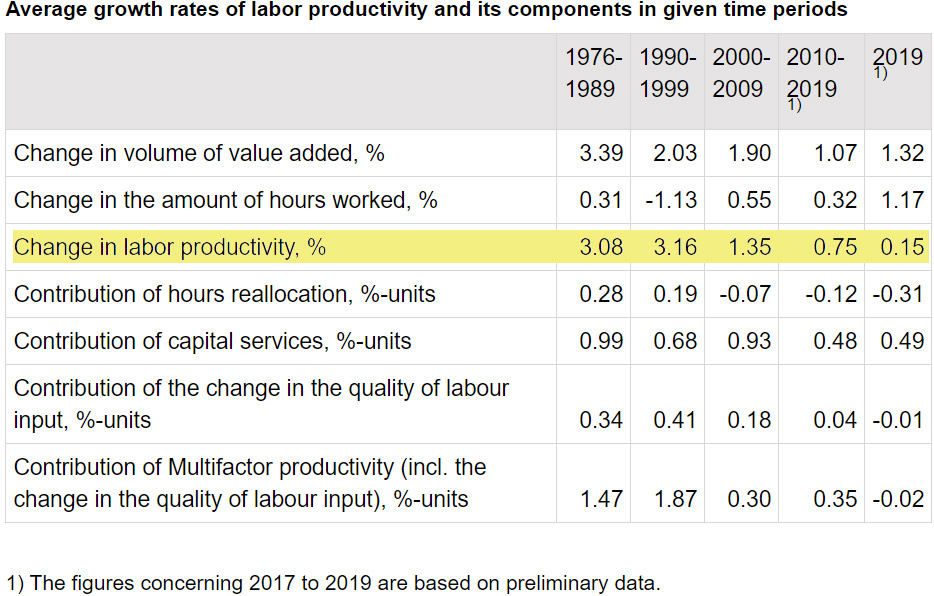Finns' labor productivity stagnated in 2019, when there was a minuscule 0.1% increase, which follows growth rates below 1% since 2010, according to Statistics Finland's preliminary national accounts data.
In fact, the data released on Thursday show that Finnish labor productivity has been declining steadily over the last half century. In the 70s and 90s, the increase in productivity exceeded 3% on an annual average, according to figures from the national statistical office.

Source: Statistics Finland.
The data table released shows that labor productivity grew by just 0.1% in Finland in 2019. "As the volume of value added grew by 1.3% and the number of hours worked by 1.2%, only slightly more value added than before was thus achieved in one hour worked," Statistics Finland says.
Down in the past decades
Statistics Finland's data also allow to examine the components of labor productivity in the past decades.
The recession in the 1990s was visible as an increase in labor productivity, as the number of hours worked contracted more than value added. Indeed, the average growth in labor productivity in the whole 1990s was of the same size as in the 1980s. In the 1990s, the average growth in value added was only 2% per year, compared to 3% in the 1980s. At the same time, the number of hours worked decreased by an average of 1% per year, so labor productivity grew by 3.1%.
The average growth in the volume of value added has slowed down further in the 2000s. During the 2000 to 2009 period, the average annual growth in value added was, however, clearly higher than the annual change in hours worked. This is visible as an increase in labor productivity. However, compared to the 1990s, the average annual growth in labor productivity halved to 1.3%.
In 2010 to 2019, labor productivity growth contracted further, being 0.7%, on average. Labor productivity was even lower in 2019, only 0.1%. In 2010 to 2019, the average growth in the volume of value added has been 1.1% per year.
The change in value added in 2019 slightly exceeds the average growth rate, being 1.3%. Although the change in the volume of value added was positive in 2010 to 2019, in relative terms its growth was slower than that of hours worked, which is visible as slowing down of the growth in labor productivity.
In 2019, annual changes in the volume of value added and hours worked were almost of the same size, which is visible as slight growth in labor productivity (0.1%).
Sanna Marin's proposal
Prime Minister Sanna Marin recently reiterated, during the keynote speech of the conference where she was elected president of the Social Democratic Party (SDP), her proposal to improve labor productivity. In a speech with strong ideological overtones, she proposed working fewer hours and earning the same salary.
"The wealth brought about by the increase in labor productivity has to be split not only between owners and investors but also to ordinary employees," emphasized Marin, who already raised the idea of a six-hour workday before becoming prime minister.
In the midst of the recession caused by the coronavirus pandemic, with more and more companies closing or laying off workers, Marin's controversial idea of cutting working hours caused an outbreak of criticism from opposition politicians, businessmen and economists.











